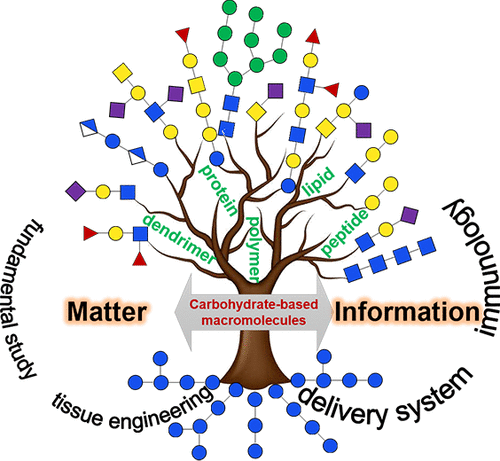当前位置:
X-MOL 学术
›
Chem. Rev.
›
论文详情
Our official English website, www.x-mol.net, welcomes your
feedback! (Note: you will need to create a separate account there.)
Carbohydrate-Based Macromolecular Biomaterials
Chemical Reviews ( IF 51.4 ) Pub Date : 2021-08-02 , DOI: 10.1021/acs.chemrev.0c01338 Lu Su 1, 2 , Yingle Feng 1, 3 , Kongchang Wei 4 , Xuyang Xu 1 , Rongying Liu 1 , Guosong Chen 1, 5
Chemical Reviews ( IF 51.4 ) Pub Date : 2021-08-02 , DOI: 10.1021/acs.chemrev.0c01338 Lu Su 1, 2 , Yingle Feng 1, 3 , Kongchang Wei 4 , Xuyang Xu 1 , Rongying Liu 1 , Guosong Chen 1, 5
Affiliation

|
Carbohydrates are the most abundant and one of the most important biomacromolecules in Nature. Except for energy-related compounds, carbohydrates can be roughly divided into two categories: Carbohydrates as matter and carbohydrates as information. As matter, carbohydrates are abundantly present in the extracellular matrix of animals and cell walls of various plants, bacteria, fungi, etc., serving as scaffolds. Some commonly found polysaccharides are featured as biocompatible materials with controllable rigidity and functionality, forming polymeric biomaterials which are widely used in drug delivery, tissue engineering, etc. As information, carbohydrates are usually referred to the glycans from glycoproteins, glycolipids, and proteoglycans, which bind to proteins or other carbohydrates, thereby meditating the cell–cell and cell–matrix interactions. These glycans could be simplified as synthetic glycopolymers, glycolipids, and glycoproteins, which could be afforded through polymerization, multistep synthesis, or a semisynthetic strategy. The information role of carbohydrates can be demonstrated not only as targeting reagents but also as immune antigens and adjuvants. The latter are also included in this review as they are always in a macromolecular formulation. In this review, we intend to provide a relatively comprehensive summary of carbohydrate-based macromolecular biomaterials since 2010 while emphasizing the fundamental understanding to guide the rational design of biomaterials. Carbohydrate-based macromolecules on the basis of their resources and chemical structures will be discussed, including naturally occurring polysaccharides, naturally derived synthetic polysaccharides, glycopolymers/glycodendrimers, supramolecular glycopolymers, and synthetic glycolipids/glycoproteins. Multiscale structure–function relationships in several major application areas, including delivery systems, tissue engineering, and immunology, will be detailed. We hope this review will provide valuable information for the development of carbohydrate-based macromolecular biomaterials and build a bridge between the carbohydrates as matter and the carbohydrates as information to promote new biomaterial design in the near future.
中文翻译:

基于碳水化合物的高分子生物材料
碳水化合物是自然界中含量最丰富、最重要的生物大分子之一。除了与能量有关的化合物外,碳水化合物大致可分为两类:作为物质的碳水化合物和作为信息的碳水化合物。作为物质,碳水化合物大量存在于动物的细胞外基质和各种植物、细菌、真菌等的细胞壁中,充当支架。一些常见的多糖具有可控制刚性和功能性的生物相容性材料,形成高分子生物材料,广泛应用于药物输送、组织工程等领域。作为资料,碳水化合物通常是指糖蛋白、糖脂和蛋白多糖中的聚糖,其与蛋白质或其他碳水化合物结合,从而调节细胞-细胞和细胞-基质相互作用。这些聚糖可以简化为合成的糖聚合物、糖脂和糖蛋白,可以通过聚合、多步合成或半合成策略获得。碳水化合物的信息作用不仅可以作为靶向试剂,还可以作为免疫抗原和佐剂。后者也包含在本次审查中,因为它们始终处于大分子配方中。在这篇综述中,我们打算对自 2010 年以来基于碳水化合物的大分子生物材料进行比较全面的总结,同时强调指导生物材料合理设计的基本理解。将根据其资源和化学结构讨论基于碳水化合物的大分子,包括天然存在的多糖、天然衍生的合成多糖、糖聚合物/糖树状聚合物、超分子糖聚合物和合成糖脂/糖蛋白。将详细介绍几个主要应用领域的多尺度结构-功能关系,包括递送系统、组织工程和免疫学。我们希望这篇综述能为基于碳水化合物的大分子生物材料的开发提供有价值的信息,并在碳水化合物作为物质和碳水化合物作为信息之间架起一座桥梁,以在不久的将来促进新的生物材料设计。
更新日期:2021-09-22
中文翻译:

基于碳水化合物的高分子生物材料
碳水化合物是自然界中含量最丰富、最重要的生物大分子之一。除了与能量有关的化合物外,碳水化合物大致可分为两类:作为物质的碳水化合物和作为信息的碳水化合物。作为物质,碳水化合物大量存在于动物的细胞外基质和各种植物、细菌、真菌等的细胞壁中,充当支架。一些常见的多糖具有可控制刚性和功能性的生物相容性材料,形成高分子生物材料,广泛应用于药物输送、组织工程等领域。作为资料,碳水化合物通常是指糖蛋白、糖脂和蛋白多糖中的聚糖,其与蛋白质或其他碳水化合物结合,从而调节细胞-细胞和细胞-基质相互作用。这些聚糖可以简化为合成的糖聚合物、糖脂和糖蛋白,可以通过聚合、多步合成或半合成策略获得。碳水化合物的信息作用不仅可以作为靶向试剂,还可以作为免疫抗原和佐剂。后者也包含在本次审查中,因为它们始终处于大分子配方中。在这篇综述中,我们打算对自 2010 年以来基于碳水化合物的大分子生物材料进行比较全面的总结,同时强调指导生物材料合理设计的基本理解。将根据其资源和化学结构讨论基于碳水化合物的大分子,包括天然存在的多糖、天然衍生的合成多糖、糖聚合物/糖树状聚合物、超分子糖聚合物和合成糖脂/糖蛋白。将详细介绍几个主要应用领域的多尺度结构-功能关系,包括递送系统、组织工程和免疫学。我们希望这篇综述能为基于碳水化合物的大分子生物材料的开发提供有价值的信息,并在碳水化合物作为物质和碳水化合物作为信息之间架起一座桥梁,以在不久的将来促进新的生物材料设计。









































 京公网安备 11010802027423号
京公网安备 11010802027423号